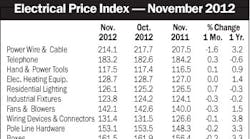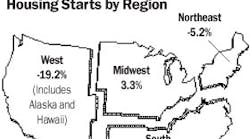Latest from Mag
People - Dec 21, 2012
Obituaries - Dec 21, 2012
November EPI Index Shows No Change
Housing Starts Dip 4% in November
Electrical Marketing - December 21, 2012
Around the Industry - Dec 21, 2012
NEMA’s Electroindustry Business Confidence Index (EBCI) for current conditions in North America fell for a second straight month in November, slipping to 65.4 points from 71.7 in October. The EBCI, a monthly survey of senior executives at member firms of the National Electrical Manufacturers Association (NEMA), Rosslyn, Va., had reached a 17-month high of 83.3 in the immediate aftermath of Hurricane Katrina in September.
While current economic conditions are solid, the EBCI index for North American market conditions six months from now slipped in November below the 50-point threshold indicative of electrical market growth. The EBCI index for future market conditions slipped to 48.1 points from 53.4 in October, the first time since the EBCI survey was initiated in 2001 that expectations for future North American conditions dropped below the 50-point mark.
Although current North American business conditions held up reasonably well in November, they have deteriorated from the recent-year highs of two months ago. Some of the reasons for respondents’ pessimism were some perceived weaknesses in the economic fundamentals for future economic conditions: strengthening of the dollar, overzealous tightening on the part of the Federal Reserve, rising energy and materials costs and the slow comeback of the nonresidential construction and utility markets.
NEMA manufacturers’ comments in this month’s EBCI reflected the uncertainty in the market. Most respondents expect a softening in the residential market, but their forecasts for the nonresidential market varied.
Said one survey respondent,"Many things could go wrong between now and the May-to-June time frame. We’re basing our planning on a baseline scenario that says that the economy will continue to grow at slightly less than the present pace, that home building will slow but not drastically, and that the long-delayed recovery in nonresidential construction finally gets going.”

